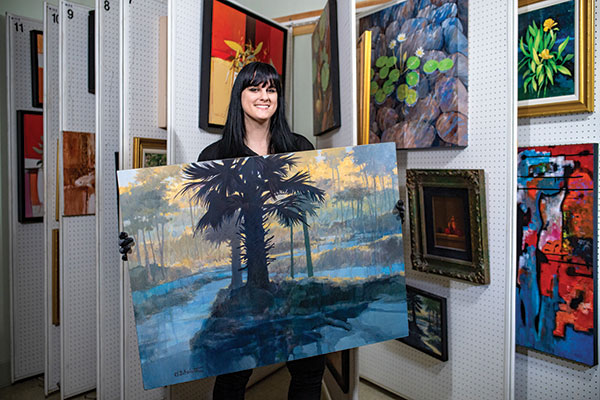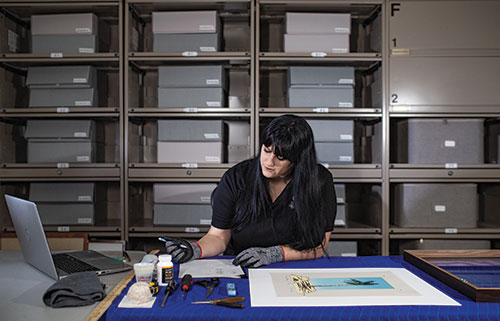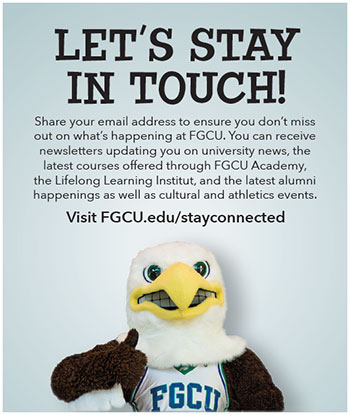Rosolen (’17, Art) gets up close and personal with the more than 3,000 pieces in the university’s Permanent and Donor and Stewardship Collections to document works for both the university and its digital collection, DigitalFGCU.
“I am head-over-heels in love with my job,” Rosolen says. “My workday is leagues above anybody’s best day – I’m surrounded by artwork all day.”

Rosolen splits her time during the week between working on campus and working offsite at the Buckingham Complex in eastern Lee County where FGCU stores most of its artwork. The university has been collecting pieces and accepting art donations for more than 20 years, and it’s Rosolen’s responsibility to make sure those pieces are both properly cared for and properly documented.
That documentation includes recording donor and artist information, photographing each piece and noting its dimensions, assigning it what is called an “accession number” so the university can quickly identify and find it, and importing that information into DigitalFGCU, where anyone with internet access can discover and enjoy the piece. (Visit fgcu.edu/digitalcollection)
“Typically, if you look at any institution, what they display is usually only about 3 percent of what they actually have in the collection,” Rosolen says. Because a lot of the pieces FGCU has are unframed prints, she says displaying them all at once would take a lot of funding. But displaying them all at once is not the goal.
“It’s not so much about quantity of pieces we’re displaying,” she says, “but really showcasing the individual donors we have … and then of course, we want the walls to be covered with art.”
“Besides the Baker Museum, there is not another institution in the area that has rotating exhibitions from their permanent collection on display. We are a resource for the students and community to see works of art by world-class artists.”
JOHN LOSCUITO, FGCU’S GALLERY DIRECTOR

Rosolen works with FGCU’s Gallery Director John Loscuito and Melissa VandeBurgt, who is its head of archives, special collections, and digital initiatives, to manage and display the collections on campus.
Students and staff across FGCU’s campus interact with artwork throughout their days, thanks to sculptures that are on display outdoors, and pieces in the Wasmer Art Gallery, ArtLab, the Wilson G. Bradshaw Library, and small collections in each building.
Since she began her role in 2018, Rosolen has helped put together exhibits on campus, such as the selection of Florida landscape paintings housed in the Student and Community Counseling Center. Those were created by the late FGCU professor and well-known local artist Carl E. Schwartz and donated by his widow, Celeste Borah.
While much of her job is dedicated to handling FGCU’s existing pieces, Rosolen is also involved in the donor process. Donors reach out to specific departments throughout the year when they have a piece they’d like to donate, or to [email protected] for the University Collections Committee to review and determine which department the item might be the best fit for. If departments decide to accept a piece, they’ll have the donors fill out an Electronic Deed of Gift and Acknowledgement of In-Kind Received form for processing.
Donors are made aware that the university might not be able to keep the work forever. In case a work will one day be sold in a public sale, they can select a specific fund for those proceeds to go to, so their gift can continue to benefit the university in the way they intended.[/vc_column_text][vc_column_text]“This collection is all thanks to the donors and the support of the community,” says Loscuito of the university’s growing body of artwork. One thing Loscuito says he considers when accepting pieces for his department is how they’ll serve students on campus, such as the educational value of a particular piece for what students are studying in FGCU’s art studios or in other departments.
“Everything we do is to serve their education,” he says. “It really is their collection.”[/vc_column_text][vc_column_text]
HOW TO DONATE ART
For details about how to support the FGCU Art Collections, contact Dolly Farrell, senior director of development, at [email protected] or (239) 590-7638.
[/vc_column_text][vc_column_text]Rosolen anticipates that the collection might see an increase in donations during the pandemic.
“The way I see it is that everybody is stuck at home,” she says with a laugh. “Maybe they’re looking at the same artwork and thinking, ‘You know what? I don’t want to look at this anymore. Let me see if the university will take it,’ and that’d be great for us.”
Rosolen says the university’s art donors tend to be older art collectors who have had time to accumulate their own large collections. “As FGCU gets older, I’d imagine the alumni will have collected artwork and will donate to their alma mater.”

One long-term goal Rosolen has for the university is to build a state-of-the-art storage facility on campus.
For Loscuito, that end goal would also make an on-campus museum a possibility.
“Besides the Baker Museum, there is not another institution in the area that has rotating exhibitions from their permanent collection on display,” he says. “We are a resource for the students and community to see works of art by world-class artists.”
Rosolen says she hopes the art on campus can have a positive impact on the students and faculty, even if it’s just to “bring them relief after a stressful day.”
“Many of the students haven’t necessarily been able to go to locations that have art that is important and significant throughout humanity. It’s important that we have a collection of art on campus so that they’re able to walk through the halls or go into their classrooms and experience the art,” she says.
“Whether they realize it or not, it’s influencing them. I think it’s just one of those things they become accustomed to seeing, and it shows them a different perspective.”
[/vc_column_text]